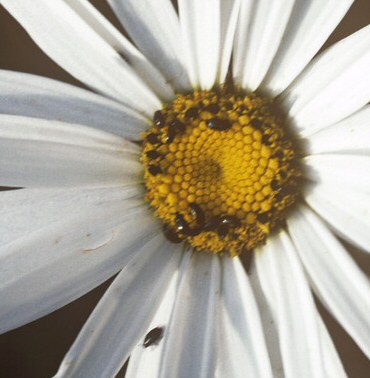- Home
- Garden Wildlife
- Insects
- Beetles
- Pollen beetles
Pollen beetles
Pollen beetles belong to the family Nitidulidae, subfamily Meligethinae. During spring and summer, the adult beetles can sometimes be seen in large numbers in various flowers. Beetles were probably the first insects to pollinate the first flowering plants 130 million years ago in the Cretaceous period, although the specialised pollinators such as bees and hoverflies are much more important now.
Species in Britain and Ireland
There are 39 species of pollen beetles in Britain and Ireland. Most are associated with wild flowers but some of the commonest species, such as Meligethes aeneus and Meligethes viridescens, develop as larvae in the flowers buds of brassica seed crops, including oil seed rape.
Pollen beetles (Meligethes sp) on Shasta daisy Adult Meligethes sp 2.5 to 4mm
Biology
Adult pollen beetles are 2-3mm long and are black or bronzy green in colour. They feed on pollen that they will take from a wide range of garden plants, with a preference for those with yellow or white petals.
None of the plants cultivated in gardens or on allotments is likely to be a host plant of pollen beetle larvae. However the adult beetles will visit flowers that are not those of their host plants when they are seeking pollen. Oil seed rape fields can produce large numbers of adult beetles in late summer after the crop has finished flowering. These beetles disperse and often come into gardens in search of pollen.
Life cycle
Pollen beetles lay their eggs on the developing flower buds of their host plants in spring or early summer. The beetle larvae feed inside the flower buds and prevent them from opening or setting seeds. When fully fed, the larvae go down into the soil where they pupate. Adult beetles emerge in late summer and feed on pollen before seeking sheltered places where they overwinter. Meligethes beetles can be a serious problem for rape seed crops, and emerging adults can be abundant enough to be a nuisance on counry walks.
Role of pollen beetles in gardens
Pollen beetles are particularly attracted to certain flowers in mid-late summer, such as roses, marrow and courgette, runner bean, sweet pea and open-centred daisy type blooms. In spring, daffodil flowers often attract pollen beetles that have emerged from their winter hiding places. Adult pollen beetles do not damage blooms but they can be a nuisance when cut flowers are taken indoors.
Pollen beetles do not eat enough pollen to interfere with the pollination process. Indeed when the beetles are crawling around in flowers, they may transfer pollen from the anthers to the stigma and in doing so bring about pollination.
Other sources of information
Books
Kirk-Spriggs, A. H. (1996) Handbooks for the Identification of British Insects Vol 5 part 6a. Pollen beetles Coleoptera
Kateretidae and Nitidulidae: Meligethinae. Royal Entomological Society
By Andrew Halstead reviewed by Andrew Salisbury edited by Steve Head

_(2691338638).jpg)
Pollen beetles
Pollen beetles belong to the family Nitidulidae, subfamily Meligethinae. During spring and summer, the adult beetles can sometimes be seen in large numbers in various flowers. Beetles were probably the first insects to pollinate the first flowering plants 130 million years ago in the Cretaceous period, although the specialised pollinators such as bees and hoverflies are much more important now.
Species in Britain and Ireland
There are 39 species of pollen beetles in Britain and Ireland. Most are associated with wild flowers but some of the commonest species, such as Meligethes aeneus and Meligethes viridescens, develop as larvae in the flowers buds of brassica seed crops, including oil seed rape.

_(2691338638).jpg)
Pollen beetles (Meligethes sp) Adult Meligethes sp 2.5 to 4mm
on Shasta daisy
Biology
Adult pollen beetles are 2-3mm long and are black or bronzy green in colour. They feed on pollen that they will take from a wide range of garden plants, with a preference for those with yellow or white petals.
None of the plants cultivated in gardens or on allotments is likely to be a host plant of pollen beetle larvae. However the adult beetles will visit flowers that are not those of their host plants when they are seeking pollen. Oil seed rape fields can produce large numbers of adult beetles in late summer after the crop has finished flowering. These beetles disperse and often come into gardens in search of pollen.
Life cycle
Pollen beetles lay their eggs on the developing flower buds of their host plants in spring or early summer. The beetle larvae feed inside the flower buds and prevent them from opening or setting seeds. When fully fed, the larvae go down into the soil where they pupate. Adult beetles emerge in late summer and feed on pollen before seeking sheltered places where they overwinter. Meligethes beetles can be a serious problem for rape seed crops, and emerging adults can be abundant enough to be a nuisance on counry walks.
Role of pollen beetles in gardens
Pollen beetles are particularly attracted to certain flowers in mid-late summer, such as roses, marrow and courgette, runner bean, sweet pea and open-centred daisy type blooms. In spring, daffodil flowers often attract pollen beetles that have emerged from their winter hiding places. Adult pollen beetles do not damage blooms but they can be a nuisance when cut flowers are taken indoors.
Pollen beetles do not eat enough pollen to interfere with the pollination process. Indeed when the beetles are crawling around in flowers, they may transfer pollen from the anthers to the stigma and in doing so bring about pollination.
Other sources of information
Books
Kirk-Spriggs, A. H. (1996) Handbooks for the Identification of British Insects Vol 5
part 6a. Pollen beetles Coleoptera Kateretidae and Nitidulidae:
Meligethinae. Royal Entomological Society
By Andrew Halstead reviewed by Andrew Salisbury edited by Steve Head












